C2 PROJECT
C2 History Pages
Dahuichang Locomotives
The history of the narrow gauge locomotives used at Dahuichang is far from clear, with sparse (and often conflicting) documentary evidence, and no photographs from the early years. We were reluctant to write this page, recognising the risk of creating or perpetuating mis-information. However, several people have expressed an interest in this data. We have attempted to pull together the probable facts into something plausible, and accept responsibility for any errors. If you know better, please let us know and we will happily correct the data!
The sources of data for this page include the following:
- Hand-written notes in a book owned by Mr Shang, who was a loco driver and fitter on the narrow gauge at Dahuichang, probably the senior driver at the time the line closed
- Locomotive log-books acquired when we bought number 4
- Evidence of works numbers stamped into components on number 4, or spare parts
- Records from the Industrial Railway Society, including handbook 2PRC (see bottom of page for details)
- Keith Chester's book 'East European Narrow Gauge' (see bottom of page for details)
- Discussions on the 'Steam in China' email newsgroup, with particular thanks to Jeff Lanham, Rob Dickinson and Bernd Seiler
- Chinese websites on narrow-gauge railway history
- Chinese technical papers from http://www.cnki.com.cn
It is worth noting here that standard gauge steam locomotives were also used in the exchange sidings at Dahuichang, including YJ287 and SY0251. They are not the focus of this article, but it is possible that some of the confusing or conflicting data about the narrow gauge may actually relate to standard gauge locos.
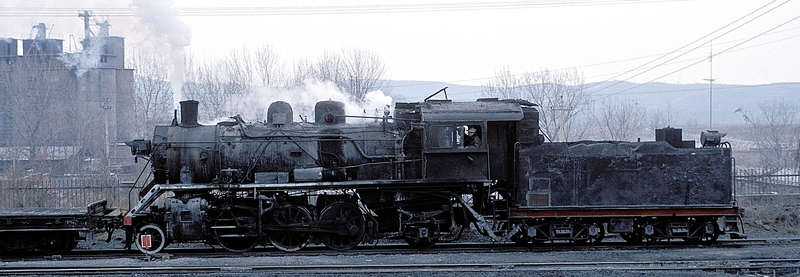
Standard gauge YJ287 at Dahuichang in 1999 (Photo: © Hansjörg Brutzer)
The factory at Dahuichang was built in 1953, and the railway opened about 1954. In 1992 it was merged into the Beijing Capital Iron and Chemical Company, and continued to operate until mid 2005, when the railway was closed and abandoned. Initially it appears that the railway was operated by two types of tank locomotive:
- Type CK 0-6-0 tank locos, 'from America', 'lighter engines'. Numbers 5 and 6. These appear on Mr Shang's list. Several Chinese sources describe American steam locos in use on the forestry railways in the North East of China in the 1950s. A review of the types listed does not clearly indicate any small American-built 0-6-0 tank locos. However, numerous 0-6-0T locos had been supplied by Baldwin to the Japanese-built Antung - Mukden (Dandong - Shenyang) 762mm gauge line in 1904/5. This line was re-gauged to standard 1435mm gauge in 1909, so it is likely that the Baldwins found further use elsewhere in China. Perhaps two made it to Dahuichang? These old locos were probably scrapped once larger motive power had been acquired.
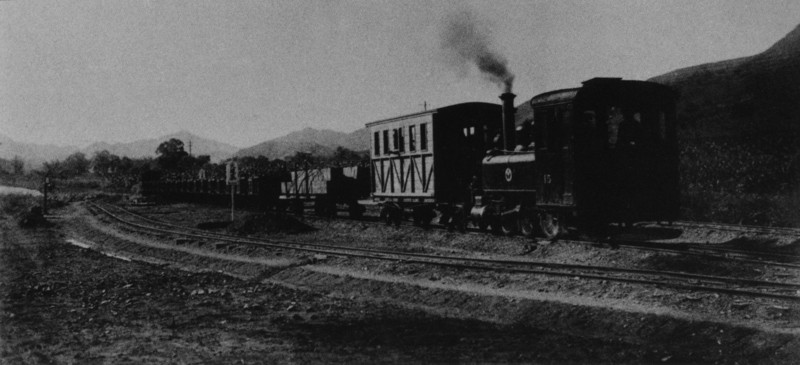
A Baldwin 0-6-0T on the Antung-Mukden (Shenyang-Dandong) railway in the 1900s. Perhaps this was the first type of loco used at Dahuichang. (from 'A Picture Album of Steam Locomotives in China', ISBN 7-113-04147-7)
- 18-tonne 0-8-0 tank locos. Mr Shang's list includes loco number 4, Dalian Works 118, which arrived in 1957 and was put into service 1958. These 18t locos were the first Chinese-built 762mm gauge locomotive type prior to the introduction of the common 28t 0-8-0 tender loco. The design was copied from a 1937 Orenstein&Koppel design built for the forestry lines in Japanese-occupied Manchuria. Dalian started construction of these in 1952; later they were also built at Zhengzhou and Chengdu and production ceased around 1965. The locos were sometimes described as 'Yun1118' class, so Mr Shang's '118' may refer to the class rather than the works number. One report states that three cabs from this type of locomotive survived in use as stores at Dahuichang into the early 2000s; we only have photographs of two of them, one with a visible number 2. The un-numbered cab had rounded windows like the Yun1118 works photo, while number 2 had rectangular windows.
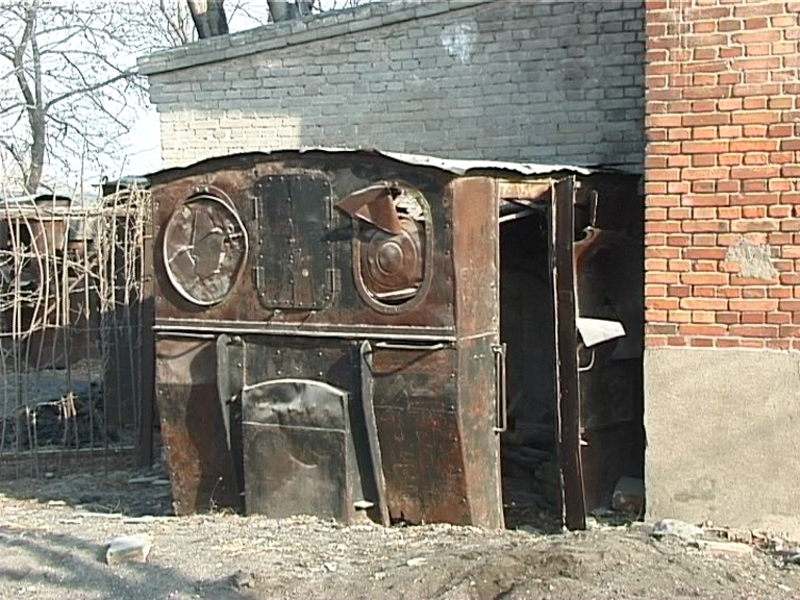
Cab of 18t locomotive, surviving at Dahuichang until 2002 (Still from video: © George Hart)
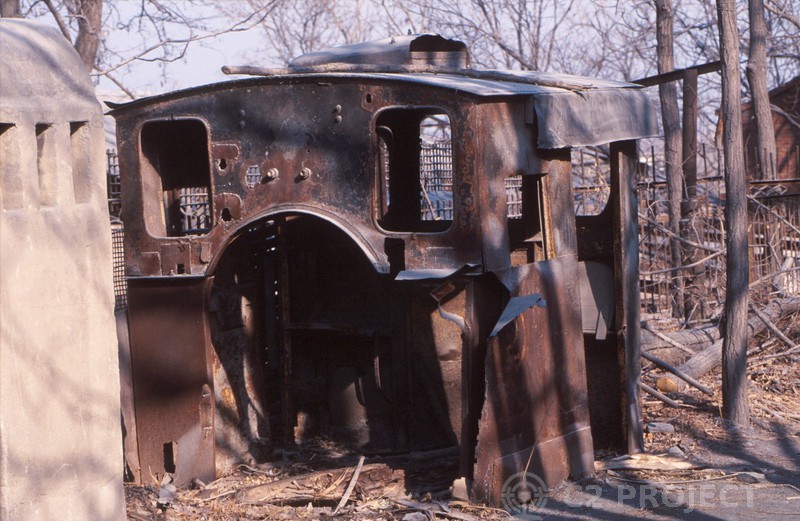
Cab of 18t loco at Dahuichang in 2000, with a number 2 clearly visible on the side. This one has rectangular cab windows, whereas the other one (above) has oval windows. (Photo: © Mark Lanham)
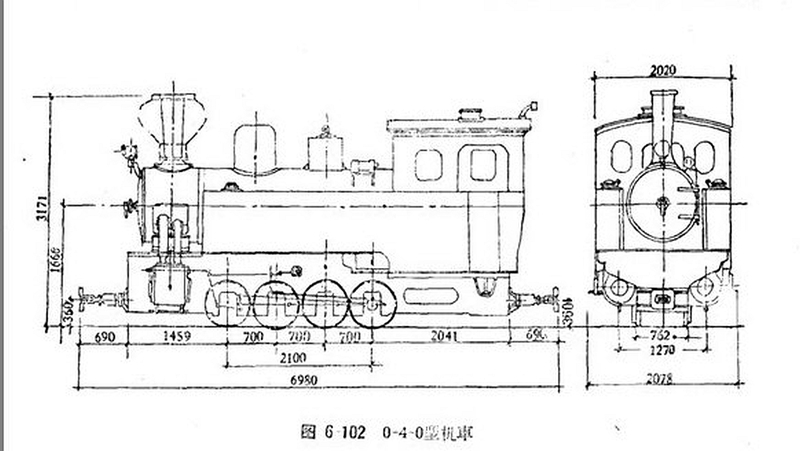
Basic dimensions of the 18-tonne locomotive, a saturated 0-8-0T built at various factories in China including Dalian.

Yun1118 class, an 18-tonne locomotive designed by Dalian Locomotive Works. Similar locos were built at Zhengzhou, Chengdu (class RJ) and Guangzhou (class SY) (Photo: © China Rail Publishing House)
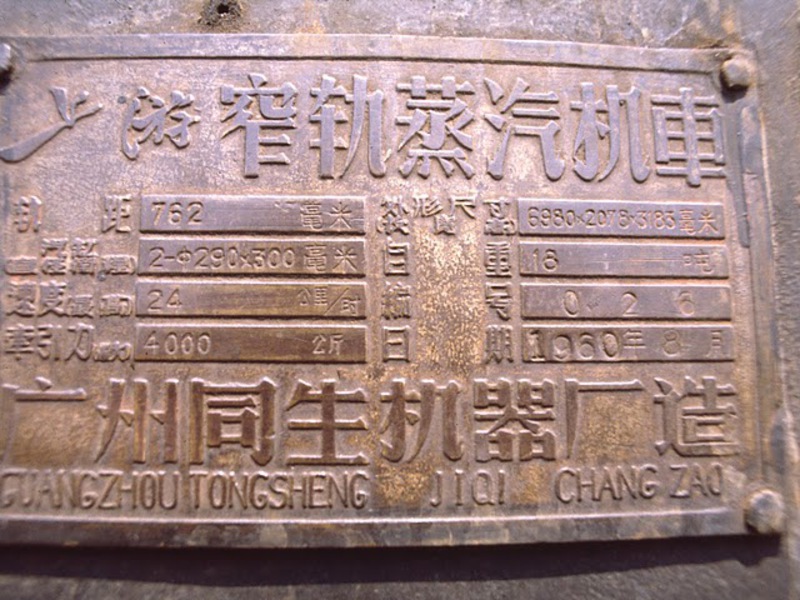
Worksplate of 18t locomotive at Lishan in 1985, showing key dimensions - not a Dahuichang loco. This one is an SY class 18t 0-8-0 built at Guangzhou - not to be confused with the standard gauge SY class 2-8-2. (Photo: © John Athersuch)
Next there appear to have been two tender locomotives of the early 28 tonne type, probably including examples built in Europe and China. Again, there is some degree of uncertainty about these:
- Type KP, Romanian loco, 1959 (From Mr Shang's list). It is fairly certain that no narrow-gauge Romanian locos were exported to China, and no 28-tonne locos of the C2 family were built in Romania. This is most likely a reference to a Polish КП-4 (predecessor of the C2, many were exported to China including some in 1959).
- Type KM-4, built at Shijiazhuang, 1961 (From Mr Shang's list). The early Shijiazhuang 28t locos were described as copies of the КП-4, but this is often written as KM-4 because the Russian 'P' (pi symbol П) looked like an M. Dahuichang had some КП-4 component drawings dated 1961 which is additional evidence of 28t locos in use at that time.
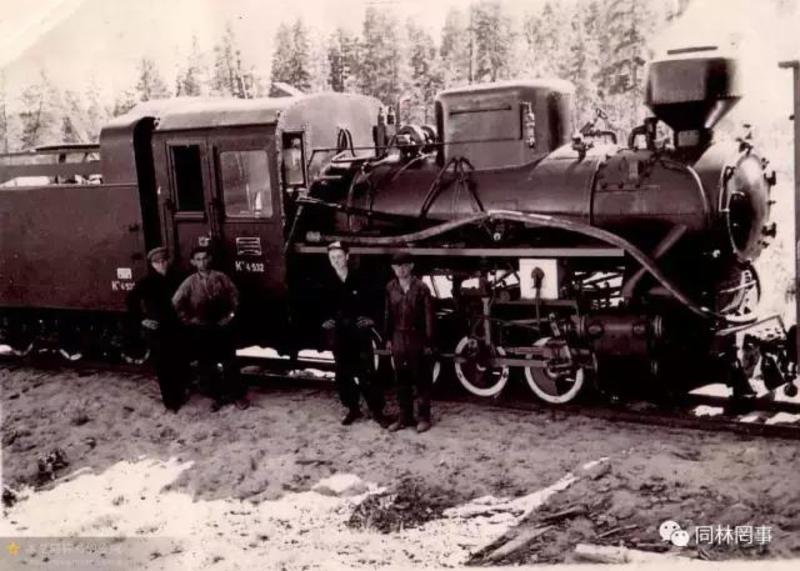
This is a Polish КП-4: the first 28-tonne locomotive supplied to Dahuichang in 1959 would have been very similar. Our loco has one Polish part, no doubt swapped during a repair. (from https://kknews.cc/news/z3ngp3a.html)
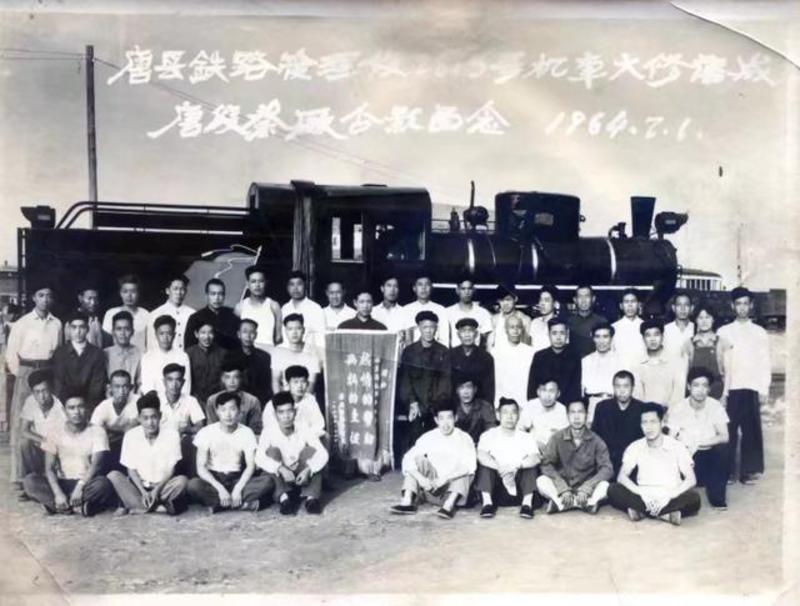
This is an early Chinese 28-tonne locomotive built at Shijiazhuang. Based very closely on the Polish drawings, the loco supplied to to Dahuichang in 1961 would have been like this. (from https://www.jianshu.com/p/211f11f1a9df)
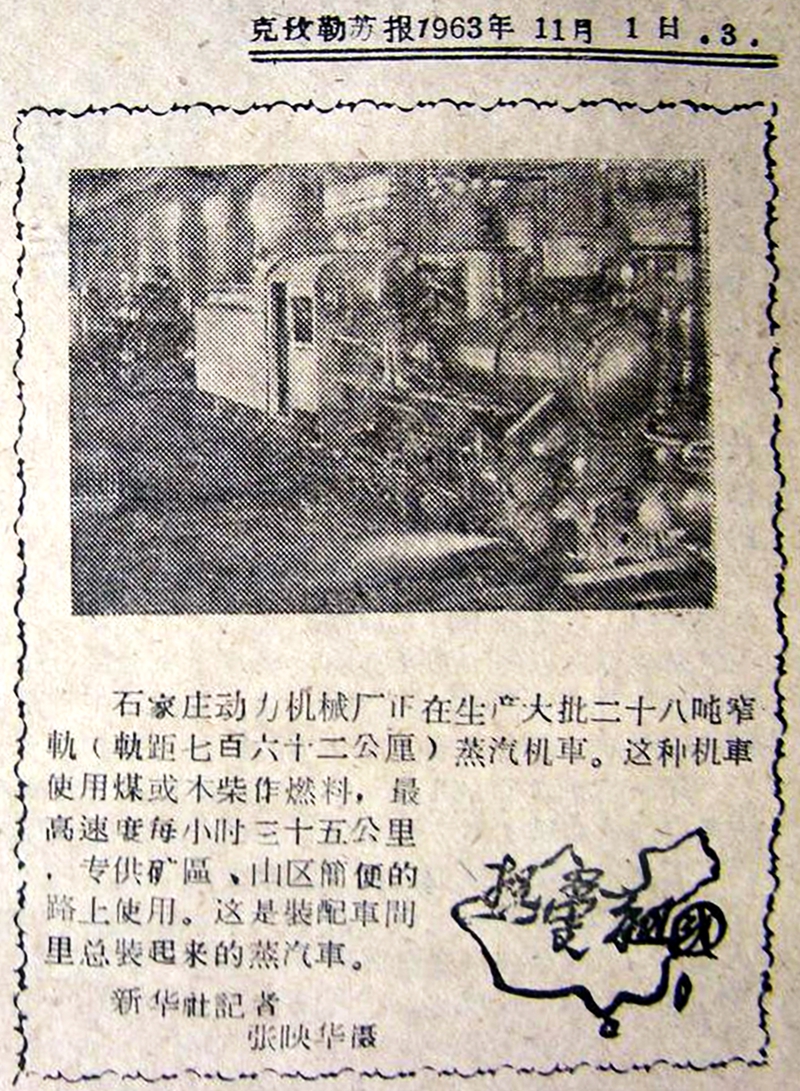
28-tonne locos under construction at Shijiazhuang, from a newspaper cutting dated 1963. By this time, Shijiazhuang referred to the locos as class ZM16-4. (Kisulsu Daily, 1/11/1963)

Title block on one of the technical drawings in the railway office at Dahuichang. Note the drawing date of 21 November 1961, and the annotation made the following day. The loco class is described in the title as КП-4 with an annotation above of 28吨 (28 tonne). There is also some Russian script. These drawings appear to have been re-drawn locally, and support the existence of 28-tonne locos at Dahuichang by 1961.
Assuming that the KP was a Polish 28-tonne loco and that there were two 18t locos, a plausible stock list covering the 1961-1983 period might be:
- #1 28t 0-8-0 KП-4 (Chrzanow 1959)
- #2 18t 0-8-0T Yun1118 (Dalian ?)
- #3 28t 0-8-0 KM-4 (Shijiazhuang 1961)
- #4 18t 0-8-0T Yun1118 (Dalian 118?/1957)
- #5 15t 0-6-0T CK (Baldwin?)
- #6 15t 0-6-0T CK (Baldwin?)
It is likely that most Western visitors to the railway at Dahuichang will never have seen most of the locomotives discussed thus far, and apart from #3 they may never have been photographed in operation.
When western enthusiasts first visited Dahuichang in the 1997-2000 period, there were five 28t locos, four of which were in working order. Clearly there had been some more additions to the fleet since Mr Shang’s list. It is reasonable to assume that the old 0-6-0T locos had been scrapped long before but the demise of the 18t locos may have been more recent as their cabs remained in reasonable condition. One might think that the history of the 28t locos would be more definite, with them being more recent and surviving to be seen and photographed by hundreds of Western enthusiasts. Sadly it is not quite that simple!
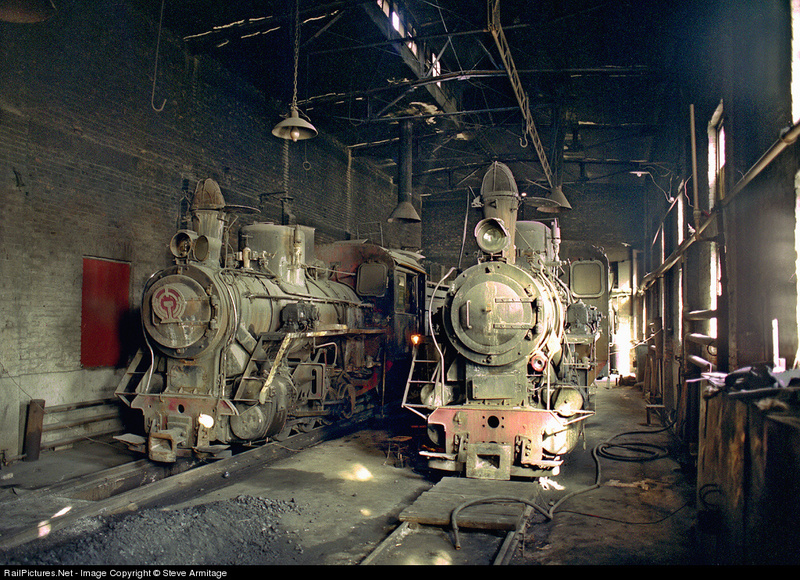
Two locos stand in the shed at Dahuichang in 2002. #1 is on the left, #2 on the right. (Photo: © Steve Armitage)

#3 and #4 in October 2004, the twilight of operation at Dahuichang. (Photo: © Brian Hawkins)
These five 28t locos were all described by enthusiasts as C2 class, the designation that Harbin Forest Machinery Factory used for their 28t locomotives. In the 1950s and 1960s Harbin-built C2s were similar to the Polish KП-4 and Shijiazhuang's KП-4 and ZM16-4, with subtle detail differences in certain components. Production of 28t locos at Harbin and Shijiazhuang ceased in the mid 1960s, but the production line at Harbin was re-started in 1975 and they continued to build C2 class locomotives at a slow rate of about 2-3 per year until the late 1980s. These later Harbin-built C2s featured an updated design, with large all-weather cabs, a longer frame and roller-bearing motion.
These newer C2s originally carried a small stamped aluminium worksplate on the cabside, and another on the tender. These were similar to those often found on electrical equipment or industrial plant, rather than locomotives. Most of these plates were removed from the Dahuichang locos at some stage. Some Harbin-built C2s also carried larger cast aluminium worksplates on the dome, but with no unique locomotive identity. If once carried by the Dahuichang locos, these would have been removed when the sandboxes were modified.
Many earlier 28t locos from all manufacturers were also rebuilt to the updated design at Harbin and elsewhere. Although the 28t locos at Dahuichang all looked identical at first glance, there were some significant detail differences which give strong clues to their origins. It is important to note that photographic evidence shows that several of the locos at Dahuichang swapped tenders at different times in their careers.
Based on reports and photos from the period, and physical evidence from our loco #4, the five 28t locos latterly at Dahuichang were as follows:
None of the five 28t locos in existence in 1997 had the distinctive features of a 1959 KП-4, so the oldest 28t loco in the fleet had probably been scrapped by then. However, it seems likely that number 3 was the same Shijiazhuang loco supplied to Dahuichang in 1961, heavily rebuilt in the intervening years.
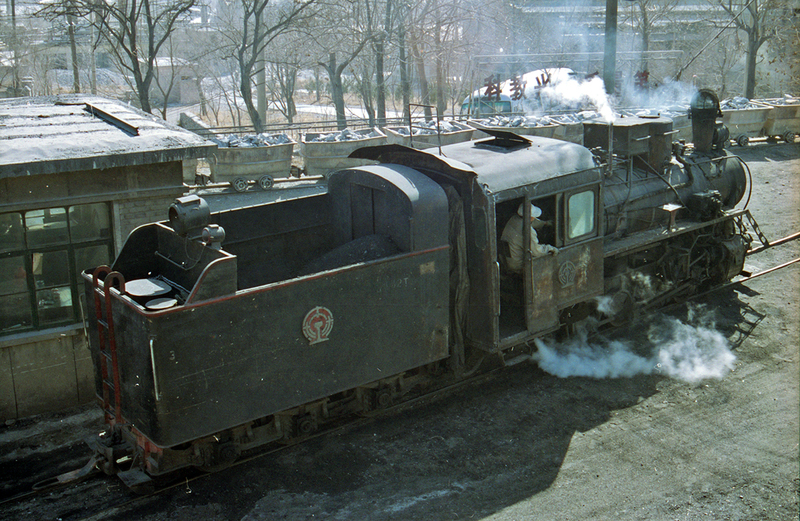
Dahuichang #3 seen in 2001. The loco has the main frame, cylinders and motion brackets typical of a Shijiazhuang loco built in the 1959-1962 period, so it could well have been the 'KM-4' supplied to Dahuichang in 1961. Many other features including the cab and the boiler have been renewed in the intervening 40 years. The tender appears to carry a Harbin worksplate and its details suggest that it was most likely supplied with loco #2 in 1986. (Photo: © Bob Whetham)
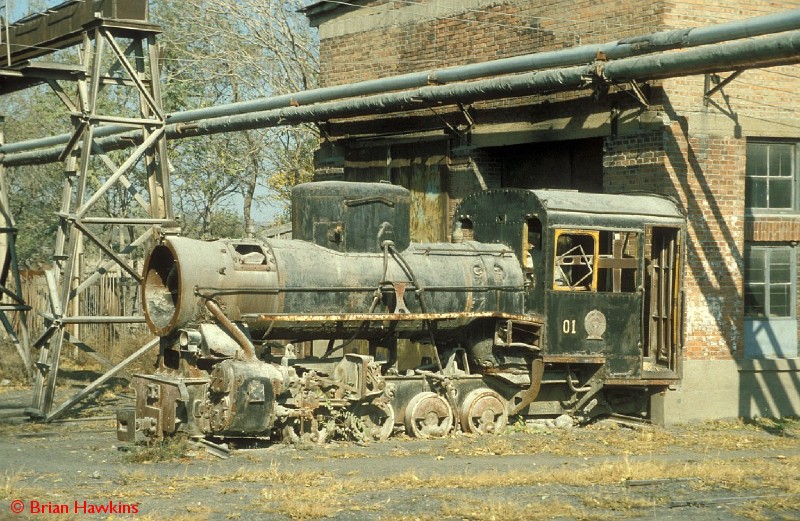
Loco 01, derelict at Dahuichang in 1999. The loco has a long frame and other characteristics typical of production at Harbin in the 1975-88 period, and is believed to be either C2-208 or C2-209. (Photo: © Brian Hawkins)
The newer list includes three later Harbin type 28t locos; numbers 01, 2 and 04. Loco 2 had a standard wide cab still carrying its worksplate to confirm its identity as Harbin 216 of July 1986. Locos 01 and 04 both originally had an unusual type of long, narrow cab.

Dahuichang #2 in 1999 showing cabside worksplate (on right), big 2, small 216 and the mandarin symbol for 'number'. (Photo: © Nicholas Pertwee)

Harbin C2 loco works plate from 216, built 7/1986. This was #2 at Dahuichang. (Photo: © Jeff Lanham)

Harbin C2 tender works plate from our 221, built 1/1988. (Photo: © Paul Molyneux-Berry)

Title block on a technical drawing in the railway office at Dahuichang; this drawing is for a component of the roller-bearing coupling rods; note the drawing number starting with C2. These C2 drawings appear to have been re-drawn locally, but sadly no dates are shown.
When we bought number 4, we also acquired all the loco logbooks that remained at Dahuichang. One pack of logbooks was for Ha’erbin 216 loco and tender (loco number 2) while the other pack contained the logbooks for loco 208 and tender 209 (dated 1983). By this time, loco 01 had been scrapped and loco 1 had been sold elsewhere, so it is possible that other logbooks had been destroyed or sold. Nevertheless, the presence of logbooks for Ha’erbin 208 and 209 strongly suggests that these were the identities of 01 and 04.
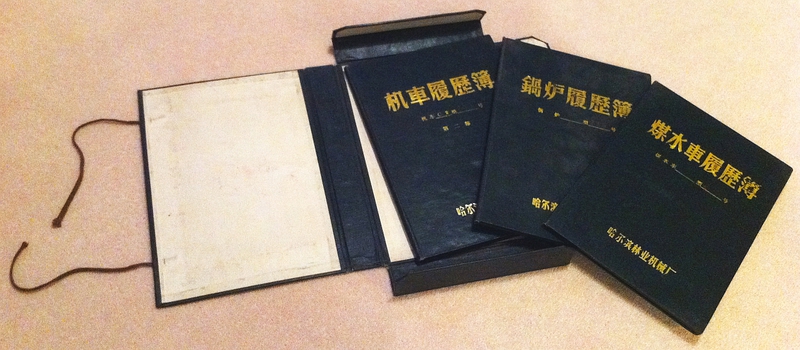
Three photos showing the locomotive log books for 208/209 as described above:
Above: the bound boxed set of three books: two for the loco and one for the tender.
Below left: Close up of the cover of the second loco book, showing the impressed number 208.
Below: One of the inside pages, with details of final inspection or test, including stamps of approval.
(Photos: © Sam Miller)
Above: the bound boxed set of three books: two for the loco and one for the tender.
Below left: Close up of the cover of the second loco book, showing the impressed number 208.
Below: One of the inside pages, with details of final inspection or test, including stamps of approval.
(Photos: © Sam Miller)

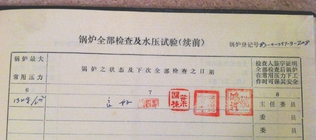
Visitors to Harbin Forestry Machinery Factory in early 1986 were told that two new C2s had just been supplied to Changchun Brick Factory, and in 1987 this number had increased to three. Harbin was building very few locos at this time, and many of them are accounted for elsewhere. Remembering that one of the facilities at Dahuichang was a brick factory, it has been suggested in some publications that Changchun was a misunderstanding for Changxindian, the district of Beijing where Dahuichang is located. If this is correct, then the two locos supplied by Harbin before 1986 would be 01 and 04 (1983), with the delivery of Harbin 216 as number 2 in July 1986 accounting for the increase to three.
However, recent evidence here shows that Dahuichang was no longer making bricks by the mid 1980s. Furthermore, Dahuichang is in the Fengtai district of Beijing, not Changxindian. The link from 'Changchun Brick Factory' to 'Beijing Building Material Chemical Factory' seems a bit tenuous in English and even more so in Mandarin.
New evidence of the previous life of Dahuichang 01 and 4 also casts doubt on the 'Changchun Brick Factory' theory. Whilst we do still believe that 01 and 4 are Harbin 208 and 209 of 1983, they were not delivered new to Dahuichang. They originally went to a railway in the far north of China at Heihe, and came to Dahuichang secondhand in the early 1990s. There is more detail on the evidence for this here.
After the delivery of Harbin 216 in 1986, it appears that Harbin supplied another 28t loco to Dahuichang, but this was an overhauled second-hand loco rather than a new one. Around this time, Harbin is known to have supplied a mix of new and secondhand overhauled locos to some other industrial customers including Xingyang brickworks, so this practice is plausible.
Several groups of western railway enthusiasts visited the Harbin forestry machinery factory in the late 1980s, and photographed the locos under overhaul. One of these was numbered 202 and had some characteristics of a Shijiazhuang-built loco. It was seen in steam on 14th October 1987, and was seen again about to enter the paintshop on 30th November 1987. Visitors were told that this loco was ‘for a mine near Beijing’. There weren’t many mines near Beijing with narrow-gauge railways, but Dahuichang was one of them. On close inspection, loco 202 has many features in common with the 28t loco at Dahuichang that was initially known as number 5, and latterly numbered 1. In the photos of 202, the accompanying tender appears to be brand new and has the characteristics of the very late construction at Harbin (such as roller bearing axleboxes). This is probably tender 221 of January 1988. The overhauled loco and new tender would have been supplied to Dahuichang in early 1988.
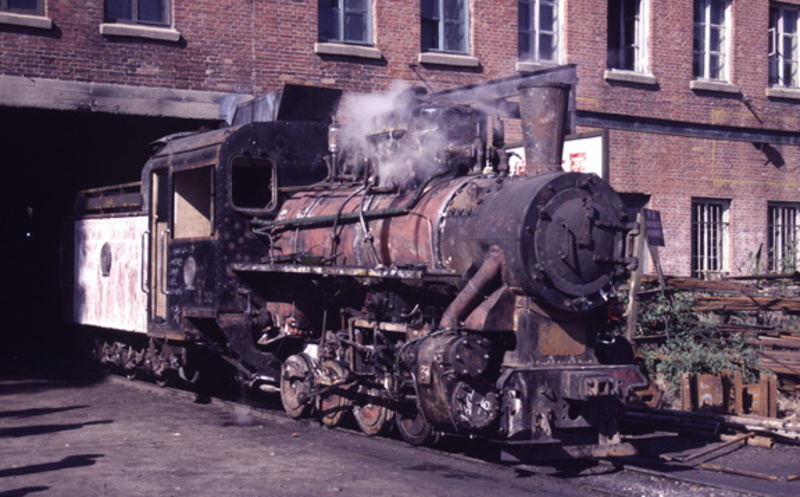
A loco numbered 202, undergoing a steam test at Harbin Forest Machinery Factory on 14th October 1987. The loco was originally built at Shijiazhuang and has received a heavy overhaul, but the tender appears brand new and may well be Harbin 221. (Photo: © Brian Pearce)
In 1989, the Dahuichang fleet probably comprised:
Loco #3 may also have had a heavy overhaul to later 'C2' appearance around this time.
By the early 1990s, Harbin Forest Machinery Factory had closed and new C2s were no longer made, but they were available on the secondhand market. It appears that Dahuichang took the opportunity to buy two relatively new (1983) C2s from Heihe, where they had been made redundant by re-gauging of their line to standard gauge.
One of these was put into traffic with very little modification as Dahuichang #4, replacing the last of the old 18t tank locos. The other loco from Heihe seems to have been used as a source of spares, and the remaining hulk still carried its original Heihe number until it was scrapped in 2000. This was the loco known as 01.
Quarry and factory output at Dahuichang was reduced by more than 50% in the early 1990s and the railway traffic would have also dropped. We can assume that at some stage the oldest Polish 28t loco was scrapped and its number #1 taken by #5.
At some stage in the 1990s the tenders were swapped around, to put the four newer 1980s tenders behind the four working locos. 01's 1983 tender ended up behind #2, #2's 1986 tender ended up behind #3, #4's 1983 tender went to #1 and the new 1988 tender supplied with #1 was paired with #4.
In the 1990s, most of the workshops overhauling 28t locos had closed, and the Dahuichang locos had to be sent to the north-east for overhaul; it appears that a loco was sent every two years. For example, in January 1998 loco 04 was in use at Dahuichang, in tatty condition with a narrow cab. Visitors to Dahuichang in October 1998 did not see 04, but by December 1998 it was back at Dahuichang in clean, ex-works condition with a wide cab. A few weeks later, visitors to Chaihe Forestry Machinery Factory were told that they had overhauled fourteen 28t locos in 1998, including one for Dahuichang. Similar evidence indicates that loco #2 was overhauled in 2000.
Based on the above, it seems likely that the C2 Project locomotive was built at Harbin Forest Machinery Factory in 1983, works number 208 or 209, both of which were probably supplied new to Heihe. They were sold to Dahuichang around 1990 becoming numbers 01 (which was used as a source of spares) and 4. Both had non-standard narrow cabs. Our loco 04 had a heavy overhaul at Chaihe Forestry Machinery Factory in 1998, when it gained its wide cab.
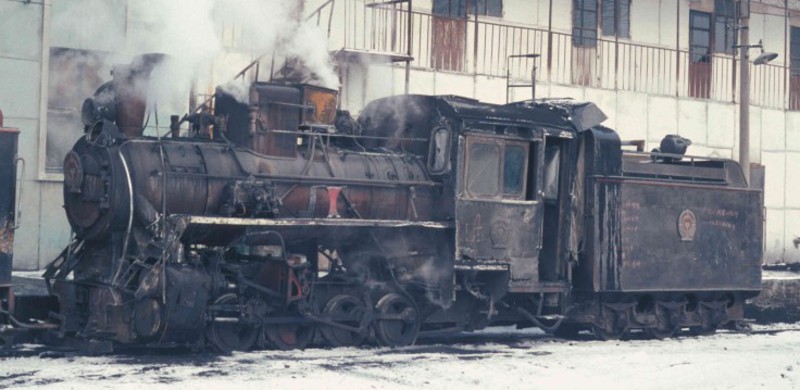
Our C2 #4 at Dahuichang in snowy early 1998. Note the narrow cab, smaller cab window and the central boiler blow-down arrangement. Later in 1998 the loco had its 10-year overhaul and returned with a bigger cab and side blow-downs. Other distinctive minor details confirm it was the same loco, and we have found evidence of these modifications during the rebuild. (Photo: © Rob Dickinson)
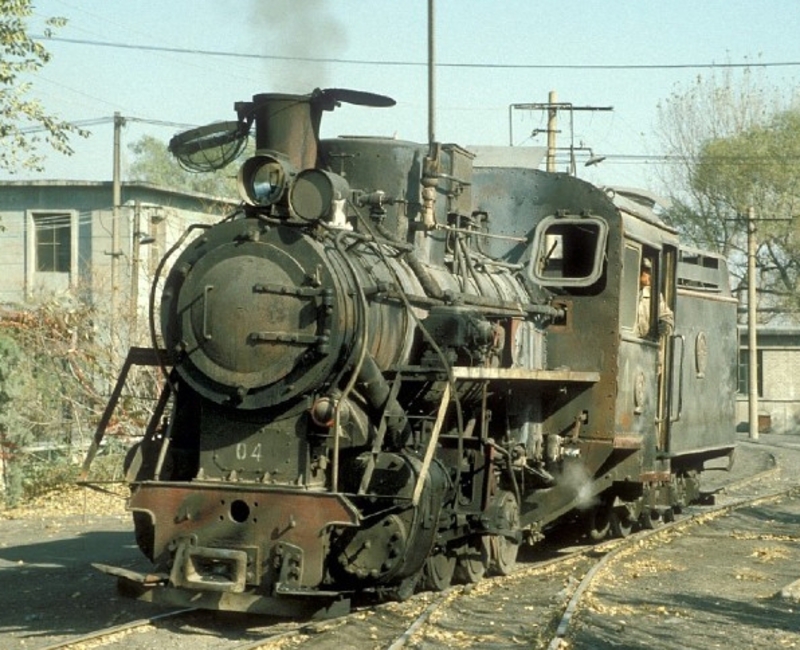
Our C2 #4 at Dahuichang in 1999, looking smarter post-rebuild and with the wider cab. At this stage it still had its leading tail lamp, and had not yet acquired the huge painted numbers. Numbers 1-3 were very similar in appearance. (Photo: © Brian Hawkins)
When the railway closed, #2 was in the middle of an overhaul at Dahuichang. This was completed, with the hope that the railway could re-open as a tourist attraction in due course, which has never happened. Loco #1 (with the tender previously coupled to #3 but originally supplied with #2) was sold within China fairly quickly, but as far as we know it has not seen any further use. When we bought #4, #2 was still standing in the shed freshly overhauled, while #3 (with #1's tender which had been originally supplied with #4) had clearly been robbed of parts to make the other three locos serviceable.As of 2019, #2 and #3 are still there, locked away in the shed!

Dahuichang #1 (with #3's tender) at Modaoshi, Heilongjiang Province, October 2006. (Photo: © Brian Hawkins)

Locos 2 and 3 in the shed at Dahuichang in 2019. (Photo: Ed or Barney)
Further Reading:
'East European Narrow Gauge', Keith Chester, 1994, ISBN 1-873150-04-0
'Industrial Locomotives of the People's Republic of China' (2PRC), R.N.Pritchard (IRS), 2008, ISBN 978 1-901556-47-6
Rob Dickinson's 'International Steam' webpages http://www.steam.dial.pipex.com/internat.htm
SY Country - Trip reports and details of surviving steam railways in China http://www.sy-country.co.uk/
Werner & Hansjörg Brutzer's album of photos from Dahuichang:
A web page about the early locos used on the Chinese forestry railways:
Papers downloaded from the Chinese online journal resource http://www.cnki.com.cn, including: